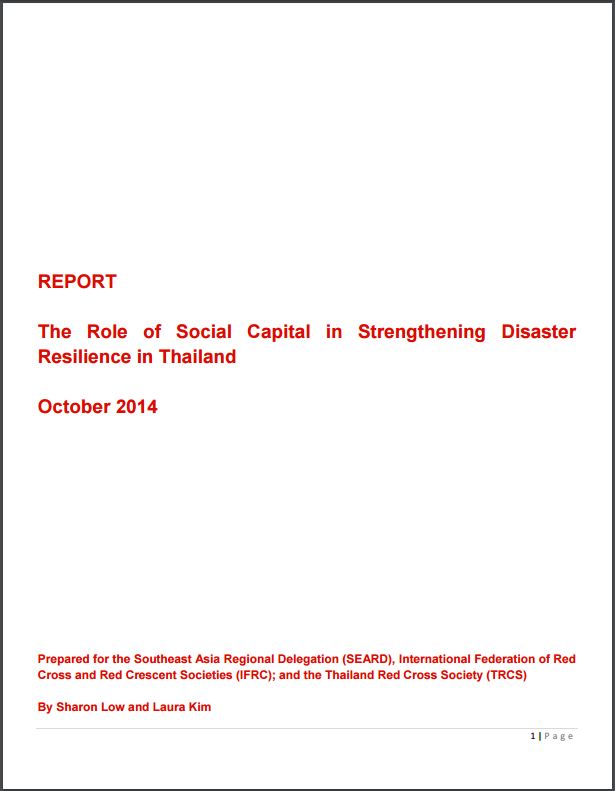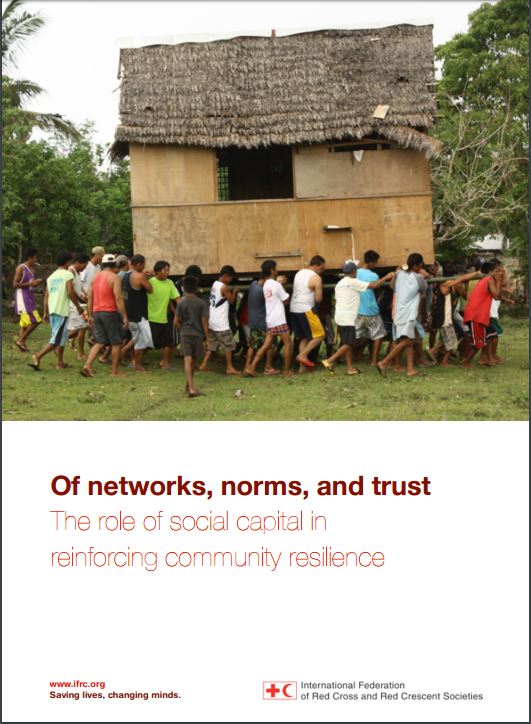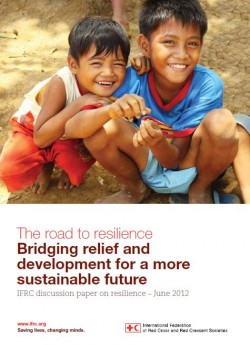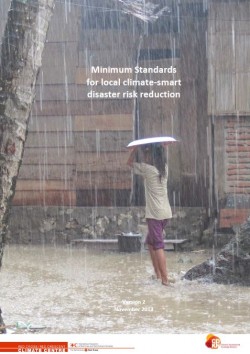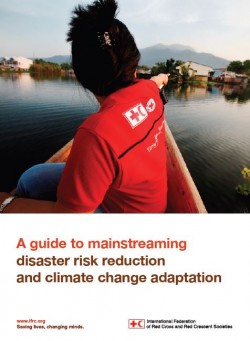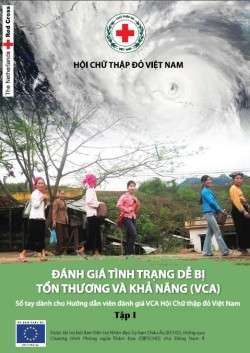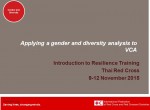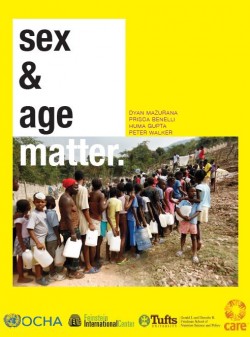The Role of Social Capital in Strengthening Disaster Resilience in Thailand
Purpose
This study aims contribute to the existing evidence base on how social capital can be harnessed to strengthen disaster risk reduction (DRR) in Thailand. While social capital is generally recognised as an important means to building community resilience, there is still little knowledge about how it can be best utilised towards DRR efforts. The study is based on a literature review and field work carried out in three communities in Thailand.
Overview
- The study finds that, despite the attachment and harmony that people feel towards their community, levels of social trust are low. This has implications not only for Thai communities’ abilities to respond to, and cope with, disasters, but also in their abilities to prosper and thrive as a nation.
- Thai communities are built on strong family ties and on strong bonds with friends and neighbours. It is a society of very strong immediate networks, in that very few people lack a support network. However, this means that, for the minority that do lack social capital, life can be extremely difficult. As such, investments in social capital must ensure that they are broad-based and inclusive, with a focus on integrating marginalised populations, such as undocumented migrant communities or political and religious minorities.
Usage: Learning from experience
Audiences: National Society leadership, Technical staff
![]()
Of Norms, Networks, and Trust. The Role of Social Capital in Reinforcing Community Resilience
Purpose
This study analyses the role of social capital in community resilience. The paper bases its analysis on recent literature and on case studies from nine communities in Nepal, China and Myanmar. The research included a household survey with 888 respondents, and workshops with communities and Red Cross branches.
Overview
- Cognitive aspects of social capital such as social embeddedness, trust and propensity to civic engagement appear to be the critical foundation on which overall resilience depends. The case of Bingalar, a Myanmar village severely affected by the 2008 Cyclone Nargis, where villagers supported each other through the first days of hardship and recovery, illustrates how social capital can make a tremendous difference to resilience and overall outcomes.
- Social capital is one of the key driving forces behind community resilience – the others being economic, human, physical and natural capital.
- The study finds that existing IFRC tools can be used to assess structural aspects of social capital if they are properly understood and used. For instance, the baseline survey tool (part of the VCA toolkit) needs to be complemented with a component that can capture cognitive social capital.
Usage: Learning from experience
Audiences: Technical staff
![]()
The road to resilience – Bridging relief and development for a more sustainable future, IFRC discussion paper on resilience 2012
Purpose:
The purpose of this document is to present key partners with the IFRC’s definition of, and perspectives on, resilience. It includes case studies from America, Asia and Africa.
Overview:
- For the IFRC, resilience is defined as the ability of individuals, communities, organisations, or countries exposed to disasters and crises and underlying vulnerabilities to anticipate, reduce the impact of, cope with, and recover from the effects of adversity without compromising their long-term.
- Interventions to strengthen resilience aim to: (a) address underlying causes of vulnerability in order to protect development; (b) reduce and mitigate radical drops in resilience caused by disasters and crises; and (c) enhance bouncing back from adversity.
- To strengthen resilience there is a need to accept that people come first. Resilience is not something outsiders can do, or bring to individuals or communities; one must respect local ownership. Dependency on outside support or substitution should be avoided as much as possible. It is also necessary to engage in comprehensive cross-sector assessments, planning and implementation, and to develop a long-term perspective. Strengthening resilience does not happen overnight and requires long-term engagement and investment; working in partnership; knowing the limits; and strengthening disaster laws and policies.
- Characteristics of a resilient community, with case studies, can be found on pp. 17-25.
Usage:Guidance for project implementation
Audience: National Society leadership, Technical staff
![]()
Minimum Standards for Local Climate‐Smart Disaster Risk Reduction
Purpose
This document developed as a practical checklist to help local community leaders and disaster risk reduction (DRR) practitioners ensure their risk reduction efforts are climate‐smart and contribute to climate change adaptation. The minimum standards are presented in two tables. Each minimum standard is supported by practical ‘actions’ to guide implementation.
Overview
- Table 1 outlines minimum standards for implementation of climate‐smart DRR activities at community level.
- Table 2 outlines minimum standards for national and provincial civil society organisations (CSOs) – or relevant local government authorities – to support communities which implement climate‐smart DRR activities.
Usage: Guidance for project implementation
Audiences: Technical staff
![]()
A Guide to Mainstreaming Disaster Risk Reduction and Climate Change Adaptation
Purpose:
This guide has been developed to support Red Cross and Red Crescent Societies and IFRC staff in more systematically integrating risk reduction measures into their planning. It describes in detail what key issues need to be considered, and when. The guidance aims at ensuring that risk reduction measures are taken into account in different sectors and contexts. It also details the key elements that need to be in place to create an enabling environment.
Overview:
- General steps for mainstreaming disaster risk reduction (DRR) and climate change adaptation (CCA) are: DRR and CCA screening. The strategy, policy, programme or project in question must be first screened with a DRR and CCA lens, and then a detailed assessment made. If this shows that disaster and climate change risks have not been duly considered or addressed, then adjustments should be made to the planned activity. A monitoring and evaluation (M&E) framework should also be developed. Mainstreaming DRR and CCA can be ensured only when the process is regularly monitored and evaluated.
- The paper details six specific programming contexts (conflict, urban, reducing vulnerability, strengthening resilience, disaster preparedness, disaster response, and recovery) and key sectors (health and care; water, sanitation and hygiene; migration; shelter and settlement; livelihood and food security; natural resource management) for mainstreaming DRR and CCA. Each of these is accompanied by specific key principles of DRR and CCA mainstreaming, as well as good practice checklists. Aside from the context-specific guidance, there are two general principles: first, a National Society needs to ensure that it has adequate capacity at relevant levels to mainstream DRR and CCA; second, given that risk patterns change, risk should be monitored at least once per year. If changes in circumstances and risk are identified, programming choices and activities may need to be adapted to these changes.
- A gender good practice checklist can be found on p.52.
Usage: Guidance for project implementation
Audiences: Technical staff
Reference: International Federation of Red Cross and Red Crescent Societies (2013). A Guide to Mainstreaming Disaster Risk Reduction and Climate Change Adaptation (pp. 1-62).
![]()
Vulnerability and Capacity Assessment (VCA): Manual for Viet Nam Red Cross Practitioners
Purpose
This guide aims to provide a comprehensive guide, for disaster risk reduction in general and particularly for those facilitating vulnerability and capacity assessments (VCA) in the community.
Overview
The manual is divided into three sections:
- The first section: ‘What is VCA’ provides conceptual information and key components, and outlines the main components that guide the Vietnam Red Cross (VNRC) facilitator while undertaking the VCA process.
- The second section: ‘Principles of conducting a VCA’ highlights important links of the VCA tool between development and disaster management. In addition, this section emphasises different approaches of conducting VCAs.
- The last section: ‘Practical Guide for conducting a VCA’ provides accessible and practical information on different VCA tools and ways to conduct VCAs with the active participation of vulnerable groups. It also provides information on the process of facilitating a VCA in the field. This section serves as the ‘how to’ guide for the facilitators, based on the information provided in the previous two sections.
Usage: Guidance for project implementation
Themes: Disaster preparedness; Risk assessment; Risk reduction / management; Community-based or community participation; Community capacity assessment; Project/programme planning
Audiences: Technical staff
For English version part 2, click here Part 2, size 0.87 MB
For Vietnamese version, click here Tiếng Việt Part 1, size 0.79 MB and Part 2 size 0.95 MB.
Citation: Vietnam Red Cross (2010). Vulnerability and Capacity Assessment (VCA). Manual for Vietnam Red Cross Practitioners Part I & II (pp. 1-48).
![]()
Gender and diversity-sensitive approach to VCA tools
Usage: Training
Audience: Gender and diversity practitioners, Communication staff, Volunteers
For Thai version, click here ภาษาไทย
![]()
Sex and Age Matter: Improving Humanitarian Response in Emergencies
Purpose
This study’s overall objective is to provide information on the collection and use of sex and age disaggregated data (SADD), and gender and generational analyses of SADD. It is intended to inform assessment processes by humanitarian actors responding to natural disasters and situations of armed conflict.
Overview
- The document focuses on five clusters (education, emergency shelter, food security, health and water, sanitation and hygiene (WASH)). Within each cluster, it presents information from the published literature on how gender and age matter within these sectors for people living in crises caused by natural disaster and armed conflict. It then draws on interviews and published literature to examine if SADD is collected by UN lead cluster agencies, their partners and local agencies operating within these clusters and if so what, if any, difference it makes for programming.
- Collection and use of SADD and gender and generational analyses enable operational agencies to deliver assistance more effectively and efficiently than without those data and findings, as illustrated by case studies and examples.
Usage: Learning from experience
Audiences: Technical staff; Gender and diversity practitioners
Reference: Dyan Mazurana, Prisca Benelli, Huma Gupta and Peter Walker, “Sex and Age Matter: Improving Humanitarian Response in Emergencies.” Feinstein International Center, Tufts University, August 2011.
![]()



